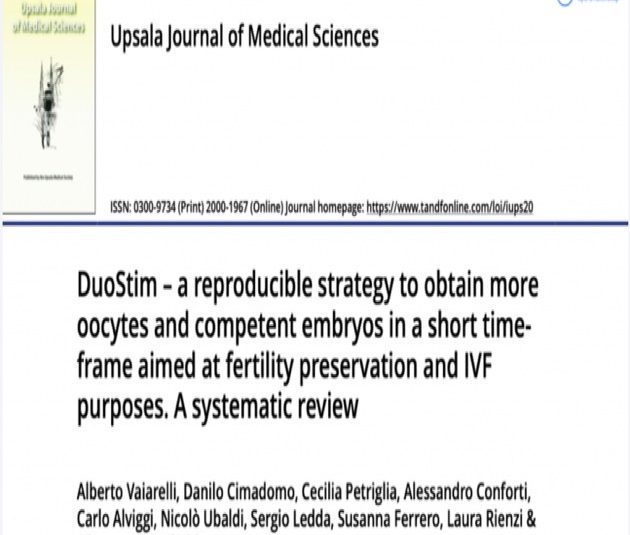
DuoStim – a reproducible strategy to obtain more oocytes and competent embryos in a short time-frame aimed at fertility preservation and IVF purposes. A systematic review
Alberto Vaiarelli, Danilo Cimadomo, Cecilia Petriglia, Alessandro Conforti, Carlo Alviggi, Nicolò Ubaldi, Sergio Ledda, Susanna Ferrero, Laura Rienzi and Filippo Maria Ubaldi
UPSALA JOURNAL OF MEDICAL SCIENCES Received 08 Nov 2019, Accepted 21 Feb 2020, Published online: 25 Apr 2020 https://doi.org/10.1080/03009734.2020.1734694
ABSTRACT
Recent evidence suggests that follicular development occurs in a wave-like model during the ovarian cycle, where up to three cohorts of follicles are recruited to complete folliculogenesis. This understand- ing overtakes the previous dogma stating that follicles grow only during the follicular phase of the menstrual cycle. Therefore, in in vitro fertilization (IVF), novel protocols regarding ovarian stimulation have been theorized based on the use of gonadotrophins to prompt the growth of antral follicles at any stage of the menstrual cycle. These unconventional protocols for ovarian stimulation aim at a more efficient management of poor-prognosis patients, otherwise exposed to conflicting outcomes after conventional approaches. DuoStim appears among these unconventional stimulation protocols as one of the most promising. It combines two consecutive stimulations in the follicular and luteal phases of the same ovarian cycle, aimed at increasing the number of oocytes retrieved and embryos produced in the short time-frame. This protocol has been suggested for the treatment of all conditions requiring a maximal and urgent exploitation of the ovarian reserve, such as oncological patients and poor responders at an advanced maternal age. At present, data from independent studies have out- lined the consistency and reproducibility of this approach, which might also reduce the drop-out between consecutive failed IVF cycles in poor-prognosis patients. However, the protocol must be standardized, and more robust studies and cost-benefit analyses are needed to highlight the true clin- ical pros and cons deriving from DuoStim implementation in IVF.
Keywords: Advanced maternal age, Bologna criteria, double ovarian stimulation, fertility preservation, DuoStim, PGT, poor-prognosis patients, poor-responder patients, reduced ovarian reserve